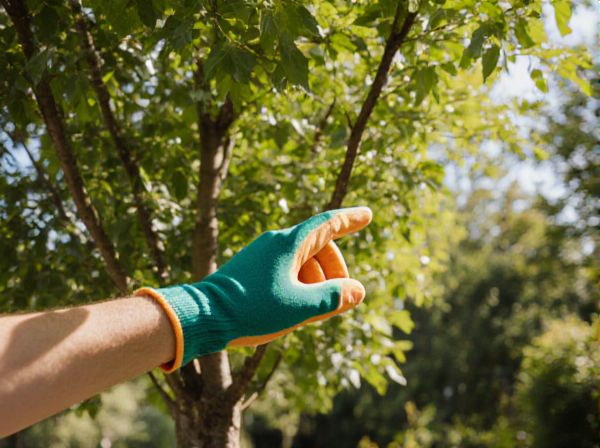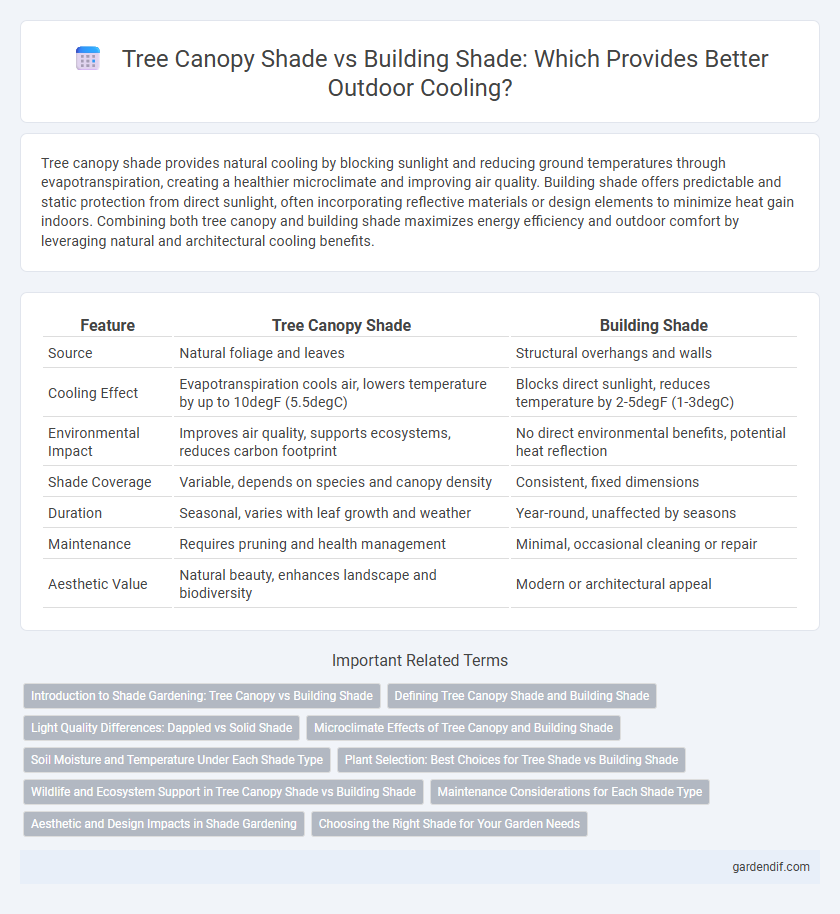
Tree canopy shade vs building shade Illustration
Tree canopy shade provides natural cooling by blocking sunlight and reducing ground temperatures through evapotranspiration, creating a healthier microclimate and improving air quality. Building shade offers predictable and static protection from direct sunlight, often incorporating reflective materials or design elements to minimize heat gain indoors. Combining both tree canopy and building shade maximizes energy efficiency and outdoor comfort by leveraging natural and architectural cooling benefits.
Table of Comparison
| Feature | Tree Canopy Shade | Building Shade |
|---|---|---|
| Source | Natural foliage and leaves | Structural overhangs and walls |
| Cooling Effect | Evapotranspiration cools air, lowers temperature by up to 10degF (5.5degC) | Blocks direct sunlight, reduces temperature by 2-5degF (1-3degC) |
| Environmental Impact | Improves air quality, supports ecosystems, reduces carbon footprint | No direct environmental benefits, potential heat reflection |
| Shade Coverage | Variable, depends on species and canopy density | Consistent, fixed dimensions |
| Duration | Seasonal, varies with leaf growth and weather | Year-round, unaffected by seasons |
| Maintenance | Requires pruning and health management | Minimal, occasional cleaning or repair |
| Aesthetic Value | Natural beauty, enhances landscape and biodiversity | Modern or architectural appeal |
Introduction to Shade Gardening: Tree Canopy vs Building Shade
Tree canopy shade provides a dynamic, dappled light environment ideal for shade-loving plants, enhancing biodiversity and cooling outdoor spaces naturally. Building shade offers consistent, often harsher shadows that limit plant growth to species tolerant of low light and heat reflection from surfaces. Selecting between tree canopy and building shade influences garden microclimates, plant health, and overall landscape design efficiency.
Defining Tree Canopy Shade and Building Shade
Tree canopy shade is created by the natural coverage of leaves and branches that intercept sunlight, providing cooling and ecological benefits by reducing surface temperatures and enhancing air quality. Building shade results from the physical structure of buildings blocking direct sunlight, often leading to localized temperature reductions but lacking the environmental advantages of vegetation. Understanding these distinctions is essential for urban planning and designing sustainable, comfortable outdoor spaces.
Light Quality Differences: Dappled vs Solid Shade
Tree canopy shade produces dappled light, characterized by soft, patterned shadows that allow some sunlight to filter through leaves, enhancing natural illumination and supporting undergrowth diversity. Building shade creates solid, uniform shadows that block direct sunlight completely, resulting in cooler and more consistent shade areas but reduced plant growth potential beneath. The quality of light significantly influences microclimates, with tree shade fostering varied light intensities while building shade offers stable but less dynamic lighting conditions.
Microclimate Effects of Tree Canopy and Building Shade
Tree canopy shade significantly reduces surface temperatures and increases local humidity by facilitating evapotranspiration, creating a cooler and more comfortable microclimate compared to building shade. Building shade primarily blocks solar radiation but often results in lower airflow and less temperature moderation since it lacks the natural cooling processes provided by trees. The presence of tree canopy shade enhances urban thermal comfort and air quality more effectively than building shade through its ability to mitigate heat islands and promote sustainable microclimate regulation.
Soil Moisture and Temperature Under Each Shade Type
Tree canopy shade significantly enhances soil moisture retention by reducing evaporation rates and lowering soil temperatures compared to building shade. Building shade tends to create cooler surfaces but often results in compacted, less permeable soil that limits moisture infiltration. Consequently, tree canopy shade supports healthier soil ecosystems by maintaining optimal moisture levels and moderating temperature fluctuations.
Plant Selection: Best Choices for Tree Shade vs Building Shade
For tree canopy shade, selecting drought-tolerant, shade-loving plants like ferns, hostas, and azaleas ensures optimal growth under filtered sunlight. In contrast, building shade areas benefit from plants adapted to lower light and cooler conditions, such as Japanese holly, boxwood, and heuchera. Understanding microclimate differences between tree and building shade zones is crucial for maximizing plant health and landscape aesthetics.
Wildlife and Ecosystem Support in Tree Canopy Shade vs Building Shade
Tree canopy shade significantly enhances wildlife habitats by providing shelter, food sources, and breeding grounds for diverse species, promoting biodiversity and ecosystem balance. In contrast, building shade offers limited ecological benefits, often disrupting natural habitats and reducing green cover essential for sustaining local wildlife populations. The presence of tree canopy shade supports vital ecological processes such as pollination and nutrient cycling, which are largely absent in areas shaded by buildings.
Maintenance Considerations for Each Shade Type
Tree canopy shade requires regular maintenance including pruning, pest control, and leaf cleanup to ensure healthy growth and optimal shading. Building shade involves less biological upkeep but demands routine inspections for structural integrity, cleaning of surfaces, and occasional repairs to shading devices like awnings or louvers. Both types benefit from tailored maintenance schedules to sustain their effectiveness and longevity.
Aesthetic and Design Impacts in Shade Gardening
Tree canopy shade enhances garden aesthetics by creating a dynamic interplay of light and shadow, adding natural texture and depth to outdoor spaces. Building shade offers structured, predictable coverage that integrates architectural elements, complementing contemporary garden designs with sleek lines and defined shadows. Both forms of shade influence plant selection and layout, with tree canopy fostering organic growth patterns and building shade encouraging minimalist, modern garden aesthetics.
Choosing the Right Shade for Your Garden Needs
Tree canopy shade provides natural cooling and enhances biodiversity while offering seasonal variability that supports diverse plant growth. Building shade delivers consistent protection from sun exposure and requires less maintenance but may limit airflow and natural ecosystem benefits. Selecting the ideal shade depends on garden goals, climate, and whether organic environmental enrichment or structural reliability is prioritized.
Tree canopy shade vs building shade Infographic

 gardendif.com
gardendif.com